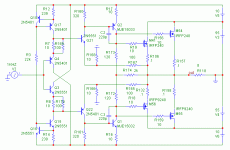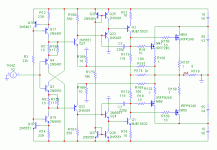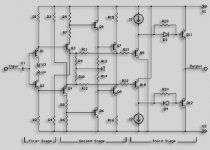Hi All
Last year I was looking at the diamond buffer and possible ways to improve it.
http://www.diyaudio.com/forums/showthread.php?postid=1626221#post1626221
But I wanted to take it further and to see if I use it as the input of a power amplifier with gain.
This circuit is what I came up with.
The Distortion is low,
The Bandwidth is high,
Output Power is considerable
It also has a pleasant side effect in that the output stage works very well biased in class B. ie zero bias current.
Before I commit to building a prototype I am interesting in hearing your opinion.
Cheers
Tim
Last year I was looking at the diamond buffer and possible ways to improve it.
http://www.diyaudio.com/forums/showthread.php?postid=1626221#post1626221
But I wanted to take it further and to see if I use it as the input of a power amplifier with gain.
This circuit is what I came up with.
The Distortion is low,
The Bandwidth is high,
Output Power is considerable
It also has a pleasant side effect in that the output stage works very well biased in class B. ie zero bias current.
Before I commit to building a prototype I am interesting in hearing your opinion.
Cheers
Tim
Attachments
Put emittor follower before Q1-Q2's base?
What makes this feature?It also has a pleasant side effect in that the output stage works very well biased in class B. ie zero bias current.
Hello,
I am sorry to say, but this amp has been already made long ago, it's an Hiraga topology.
http://www.jls-info.com/julien/audio/hir_sch.jpg
The original Hiraga used bipolars for the last stage instead of mosfets but the core of the schematic is the same. That said, the Hiraga is well known for it's very delicate and dynamic sound. The original runs in class A, but Iam sure it would be good in class AB too.
You can find the original article in 3 parts about this mythical amp at
http://www.tcaas.btinternet.co.uk/hiraga.htm
This is the 20W class A.
Another well known amp from Elektor used this principle if I remember, it must be "the compact" or something.
Well done anyway! This is a good idea, but not new.
Regards
I am sorry to say, but this amp has been already made long ago, it's an Hiraga topology.
http://www.jls-info.com/julien/audio/hir_sch.jpg
The original Hiraga used bipolars for the last stage instead of mosfets but the core of the schematic is the same. That said, the Hiraga is well known for it's very delicate and dynamic sound. The original runs in class A, but Iam sure it would be good in class AB too.
You can find the original article in 3 parts about this mythical amp at
http://www.tcaas.btinternet.co.uk/hiraga.htm
This is the 20W class A.
Another well known amp from Elektor used this principle if I remember, it must be "the compact" or something.
Well done anyway! This is a good idea, but not new.
Regards
lumanauw said:Put emittor follower before Q1-Q2's base?
That would increase the open loop gain and increase it bandwidth. I will give it a try soon.
What makes this feature?
Originally I was biasing the outputs for about 200mA of bias per device but the distortion was pretty high (about 0.1%). Later I changed some component values but I didn't notice that the output devices were biased off before checking the output distortion. I found the distortion had dropped considerably with less than 2mA bias through the output devices.
I believe it is the separate feedback paths around each output device that makes it behave linearly and possibly while the output devices are switched off current is sourced from the input stages.
bear said:Gain?
Actual distortion spec?
_-_-bear
According to the simulation it is <0.005% at full output swing into 8 ohms.
It is about 0.0007% distortion a 1V output swing into 8 ohms.
But since i measured these on a simulation these figures are only indicative that I have low distortion and I won't actually know until I build a prototype.
Cheers
Tim
Hi Daren
You are right this design has been done before.
But there is rarely any new circuit designs that have not been done before.
I was aware of a series of designs that came out of Elektor (and I wish I could find the circuits again) and I do remember seeing the schematic for Hiraga's design (but I had completely forgot about it otherwise I would have studied his work).
Is my design is different enough to stand by itself?
My variation does seem to achieves a lower distortion with the output stage biased to class B other than class AB or A.
Cheers
Tim
You are right this design has been done before.
But there is rarely any new circuit designs that have not been done before.
I was aware of a series of designs that came out of Elektor (and I wish I could find the circuits again) and I do remember seeing the schematic for Hiraga's design (but I had completely forgot about it otherwise I would have studied his work).
Is my design is different enough to stand by itself?
My variation does seem to achieves a lower distortion with the output stage biased to class B other than class AB or A.
darian said:Hello,
I am sorry to say, but this amp has been already made long ago, it's an Hiraga topology.
http://www.jls-info.com/julien/audio/hir_sch.jpg
The original Hiraga used bipolars for the last stage instead of mosfets but the core of the schematic is the same. That said, the Hiraga is well known for it's very delicate and dynamic sound. The original runs in class A, but Iam sure it would be good in class AB too.
You can find the original article in 3 parts about this mythical amp at
http://www.tcaas.btinternet.co.uk/hiraga.htm
This is the 20W class A.
Another well known amp from Elektor used this principle if I remember, it must be "the compact" or something.
Well done anyway! This is a good idea, but not new.
Regards
Cheers
Tim
Hi TimS
Have you thought about trying a different VAS. Here are a few different ones ...
FA3 ... http://www.diyaudio.com/forums/showthread.php?s=&postid=1711835#post1711835
Abomination ... http://www.diyaudio.com/forums/showthread.php?s=&postid=1700452#post1700452
Krill ... http://www.diyaudio.com/forums/showthread.php?s=&postid=1711068#post1711068

Have you thought about trying a different VAS. Here are a few different ones ...
FA3 ... http://www.diyaudio.com/forums/showthread.php?s=&postid=1711835#post1711835
Abomination ... http://www.diyaudio.com/forums/showthread.php?s=&postid=1700452#post1700452
Krill ... http://www.diyaudio.com/forums/showthread.php?s=&postid=1711068#post1711068
lumanauw said:Put emittor follower before Q1-Q2's base?
As suggested by Lumanauw (thank you) I put an emitter follower before Q1 and Q2 and it improved the performance even more.
You should also notice that R169 and R170 are not 100R any more. I found that you can trim the diamond stage current matching and cancel the distortion even further. This in turn does increase the output bias which does increase the distortion, so R172 and R173 have to be adjusted as well to keep the 3-6mA/stage output bias.
With these tweaks the
distortion drops to 0.002% and the
output impedance is 0.001R.
(All simulated for the moment)
With such a low output impedance the amp can drive a 2R load with ease and low distortion.
A cool running amp, such as this design, is very useful in the hot summer days that we are having in New Zealand at the moment.
Cheers
Tim
Attachments
lumanauw said:Put emittor follower before Q1-Q2's base?
As suggested by Lumanauw (thank you) I put an emitter follower before Q1 and Q2 and it improved the performance even more.
You should also notice that R169 and R170 are not 100R any more. I found that you can trim the diamond stage current matching and cancel the distortion even further. This in turn does increase the output bias which does increase the distortion, so R172 and R173 have to be adjusted as well to keep the 3-6mA/stage output bias.
With these tweaks the
distortion drops to 0.002% and the
output impedance is 0.001R.
(All simulated for the moment)
With such a low output impedance the amp can drive a 2R load with ease and low distortion.
A cool running amp, such as this design, is very useful in the hot summer days that we are having in New Zealand at the moment.
Cheers
Tim
Dear Tim,
Been looking for a Hiraga 20W biased into Class AB or B and your post was returned. Since this post is almost years now, I wonder if you were able to build this amplifier?
I had built a JLH Class A (single supply and dual supply on Geoff's page) but since I'm located at a tropical country, The amp gets really hot and I have to put a box fan to cool the heatsink.
I'm very much interested to build your amp although I would appreciate if the output amp can be changed to a bipolar transistor (have extra MJ15024G).
Would appreciate your advice and further information.
Best regards,
Nuki
- Status
- This old topic is closed. If you want to reopen this topic, contact a moderator using the "Report Post" button.
- Home
- Amplifiers
- Solid State
- Diamond Amp


